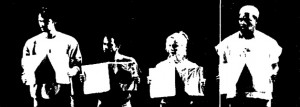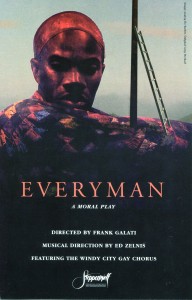Steppenwolf Downstairs Mainstage Theatre, Chicago
November 22, 1995 – January 14, 1996

At right, with castmates Anthony Diaz-Perez, Ajay Naidu, and Mariann Mayberry, ready to play Everyman if the audience chooses him for that particular performance
Critical Response
“In the Steppenwolf production, which features a multicultural cast of 16 and a chorus of 28, earthly decadence takes the form of a dance club, where bacchanalian sex of all varieties is suggested by the gyrations of a youthful, self-satisfied crowd. The summoning takes the form of an elegantly executed lottery, in which any of four actors (Mariann Mayberry, Johnny Lee Davenport, Anthony Diaz-Perez or Ajay Naidu) may be targeted as Everyman at any given performance. On Saturday, Mayberry, whose girlish, luminescent beauty makes the arrival of Death seem especially poignant, was the chosen one. . . . Unable to fend off Death, Everyman attempts to at least find companionship for the journey. But in this case, Mayberry’s boyfriend, Fellowship . . . [and] her prized possessions . . . also abandon her as do Beauty . . . Strength (Johnny Davenport) and Five Wits.”
—Hedy Weiss, Chicago Sun-Times (December 4, 1995)
“The performers, dressed in casual contemporary clothes, convey the poetry’s heartfelt ideas and fluid metric and rhyme schemes cleanly and directly. Cheryl Lynn Bruce is especially e!ective as a compassionate but determined Death. Also good are Johnny Lee Davenport’s Strength, Lou Ferguson’s God, adolescent Jay Kiecolt-Wahl’s Five Wits, and Kyle Hall’s Beauty. . . Everyman is played on different nights by one of four actors, reportedly chosen randomly at each performance.”
—Albert Williams, Chicago Reader (December 7, 1995)
“Death calls on Everyman. (In staging that painfully reflects life, it was Johnny Lee Davenport—one of four possible choices—the night we saw the production.) . . . Davenport shows the transition from carefree reveler to doomed penitent in a powerful characterization that starts little nagging voices running in our heads as we sense the universal truth of Everyman’s situation.”
—Kevin P. Murphy, The Hammond Times (December 9, 1995)
“[Galati] used the text of Everyman as written, but in adapting it for a contemporary audience with modern stagecraft and images he reconceived the play in an urban, industrial setting. The stage was left open to the back wall of the warehouse-like theater. Actors, dressed primarily in sneakers, jeans and T-shirts, looked like they could have stepped off the streets of Chicago’s trendy North Side. The initial dance sequence, in which Everyman was selected by Death, was as raw and sexual as any MTV video, and when Fellowship appeared he stepped out of a pickup basketball game. . . . Galati stressed the randomness and unexpectedness of Death. The role of Everyman was played by an actor chosen by lottery at the start of each performance; most of the cast members were young and athletic, so it was easy to believe they had given no thought to Death before she made her entrance . . . . Johnny Lee Davenport, Everyman in the performance I saw, turned most of his soliloquies into arias of anger and despair.”
—Ann James, The Christian Century, Volume 113.5 (February 7, 1996)

